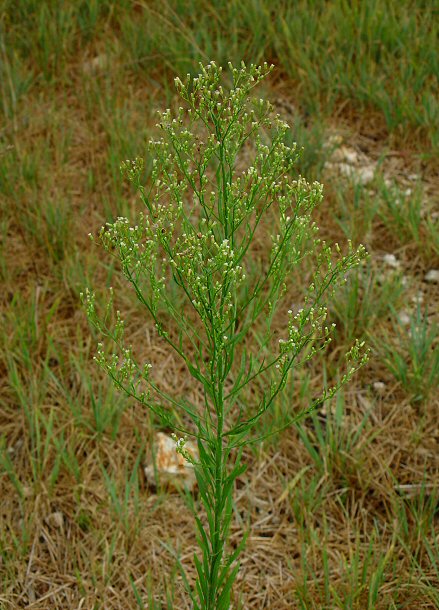Conyza canadensis (L.) Cronquist
Horseweed

Native
CC = Amb
CW = 3
MOC = 72
© DETenaglia
Conyza canadensis (L.) CronquistHorseweed | |
 |
Native CC = Amb CW = 3 MOC = 72 |
© DETenaglia |
|
Family - Asteraceae/Astereae Habit - Taprooted annual forb, usually robust. Stems - Strongly ascending to erect, highly variable (5 cm to 2.5 m), ridged, usually branched above the midpoint, usually pubescent with spreading white hairs.
Leaves - Alternate, numerous, simple, entire, 0.5-10.0 cm long, sessile or short-petiolate. Blades linear to oblong-lanceolate or oblanceolate, glabrous or more commonly sparsely to moderately hairy, mostly along the margins and midvein.
Inflorescences - Panicles at branch tips, usually dense and well developed at apex of larger plants. Shorter plants with correspondingly smaller inflorescences, sometimes appearing as short racemes.
Heads - Radiate. Involucre 2.5-4.0 mm long, cup-shaped or slightly bell-shaped or urn-shaped. Involucral bracts in 2-4 unequal, overlapping series, narrowly lanceolate to linear, the tip green or white and ascending, with a slender to relatively broad, green or brown central stripe, and with relatively slender, thin, pale margins, glabrous. Receptacle flat or nearly so, relatively smooth.
Ray flowers - 20-40 in 1-3 series, pistillate, the corolla inconspicuous, the strap-shaped portion 0.2-0.8 mm long, sometimes reduced to a short fringe at the tip of the slender tube, white, shed before fruiting.
Disk flowers - Relatively few (8-28), perfect, the corolla 1.5-2.5 mm long, yellow, shed before fruiting. Pappus of the ray and disc florets similar, of numerous capillary bristles, 2-3 mm long, usually white. Fruits - Achenes 1.0-1.5 mm long, narrowly oblong in outline, flattened, the angles usually with inconspicuous nerves, the surface usually sparsely to moderately and minutely hairy, light tan to pale grayish brown.
Flowering - June - November. Habitat - Fields, disturbed sites, waste ground, roadsides, railroads. Origin - Native to the U.S. Lookalikes - Distantly, Erechtites hieraciifolius. Other info. - This coarse, weedy plant is found across Missouri, and everywhere else in the continental U.S. It is a common sight in pastures and fallow fields, and is easily recognized by general appearance. However, it is highly variable, with flowering specimens ranging in size from a few inches to eight feet or more tall. The degree of branching is also highly variable. The flowering heads are quite small and must be examined closely to observe the ray florets. Photographs taken off Hwy 60, Carter County, MO., 7-19-03 (DETenaglia); also at Shaw Nature Reserve, Franklin County, MO, 8-13-2007, Holly Ridge Conservation Area, Stoddard County, MO, 8-15-2009, near Washington, Franklin County, MO, 8-25-2016, and along the Katy Trail near Dutzow, Warren County, MO, 8-16-2020 and 8-4-2024 (SRTurner). |